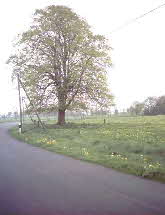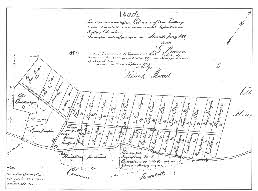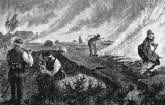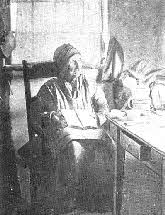|
In 1778 Rencke Janssen, the son of a farmer's daughter from Strackholt and a Lengener servant, Johan Rencken, for the purpose of attaining an inheritable lease, requested a survey of a tract of virgin land in the size of 3 Diemat (ca. 1.5 hectare) 1/2 miles east of Strackholt. Leasing agent von Halem endorsed the application. The surveyor, von Northeim, was commissioned to do the survey June 10, 1778. However, Janssen was granted less than 3 Diemat, because there was not enough sandy soil present. In addition, there were other problems. The farmers of Strackholt claimed this land as a part of their cattle pasture. During the following two years there was a tug-of-war finally leading to a settlement between Janssen and the Strackholt farmers.

On July 24, 1780, von Northeim measures out a plot of 3 Diemat and 281 Quadratruthen. Other interested parties followed suit. The second homesteader was a brother of Rencke Janssen, Claas Janssen, 1784-1786. His land lay eastward, across from the presentday Zwischenberger Weg. (see map) and, a second site to the north of the Mittelweg (where the Gerdes family now lives).
Vossbarg belonged to Strackholt until 1787, becoming autonomous after that.
Thus, 1787 is considered to be Vossbarg's year of founding.

Other settlers followed: in 1791/92 Otto Christoffers; around 1793/94, Jan Focken and Harm Habben. Then a flood of requests came in, leading to a systematic division of the moorlands in Vossbarg. In the beginning, the new colony met with great success. Around 1800 there were ten houses in Vossbarg; in 1823, 34 houses, and in 1852, 63 houses. There were 174 residents in Vossbarg in 1821 with a count of 394 residents in 1848.
(Sanders: Wiesmoor, Its Cultivation and Settlement From the Perspective of the Area Communities)
 The practice of burning the moors was utilized here. The peat was harvested only for personal fuel needs. Since there was no canal present, there was no way to transport large quantities of peat. After some years the moorland soil was depleted. Vossbarg, too, which had had a promising beginning, experienced spreading poverty. The heads of families hired themselves out as day laborers to the moor companies in Spetzerfehn or Grossefehn. Others sought work as harvest hands in the marsh areas or in Holland. In this dire time, as elsewhere throughout Ostfriesland, Vossbarg citizens were persuaded to emigrate to America in response to the exciting reports coming from there. The practice of burning the moors was utilized here. The peat was harvested only for personal fuel needs. Since there was no canal present, there was no way to transport large quantities of peat. After some years the moorland soil was depleted. Vossbarg, too, which had had a promising beginning, experienced spreading poverty. The heads of families hired themselves out as day laborers to the moor companies in Spetzerfehn or Grossefehn. Others sought work as harvest hands in the marsh areas or in Holland. In this dire time, as elsewhere throughout Ostfriesland, Vossbarg citizens were persuaded to emigrate to America in response to the exciting reports coming from there.
Claas Janssen, Vossbarg’s second resident, died in 1830. After the decree of the French occupation in 1811, he had taken on the family name, Zimmermann (that means: carpenter). His grandchildren, Claas Janssen Renken Zimmermann and Tamme Renken Zimmermann emigrated to America. Through the internet, a constant contact has been maintained with these descendents since 1998.
Claas Janssen Zimmermann was also an ancestor of my wife, Thea, nee Becker. The certainty of this connection was established through the recently published Ortssippenbuch of Strackholt.
In addition, descendants of Rencke Janssen emigrated to America. In the spring of 2001 I found web site of Ron Zimmermann. Contact initiated by me and the information of Ron Zimmermann and the entries in the Strackholt Ortssippenbuch confirmed these familial connections.
 The most famous resident of Vossbarg is, without a doubt, "Jantjemoej," Jannchen Willms Brinkmann Saathoff, a great-great-great grandmother of my wife. The most famous resident of Vossbarg is, without a doubt, "Jantjemoej," Jannchen Willms Brinkmann Saathoff, a great-great-great grandmother of my wife.
She was born October 25, 1803. She lived with her husband, Balze Janssen Saathoff, in a small moor hut on the edge of Zwischenbergen. After the death of her husband in 1900 she lived on alone another 5 years in her hut. Her 100th birthday was dutifully celebrated in Vossbarg. Not until age 103 did she require any assistance and she moved into the home of her son at Felde. She died there in 1908 at the age of 105.
By the end of the 19th century, the situation in Vossbarg had improved. Artificial fertilizers were in use and the crop yields increased. A particular blessing for Vossbarg was the founding of the power-station at Wiesmoor. Many men and women were employed here in the production of peat as fuel for the power-station..
Read a narrative of a visitor to Jantje!
Through the efforts of the villagers, the 200th anniversary of the founding of Vossbarg was celebrated in 1987. Heinz Saathoff, the Vossbarg village manager, published an anniversary booklet for the occasion. Richard Ahlrichs, a teacher and native of Vossbarg, wrote the text. Numerous old photos and documents were produced by the residents and printed in the booklet or displayed in the school building of Vossbarg. The entire community was spruced up festively for the occasion. In 1972, Vossbarg came under the jurisdiction of Wiesmoor as a result of the district reforms instituted by the state of Lower Saxony.
Descendants of Claas Janssen Zimmermann are to find on the genealogical web site of
Klaus Köppe, Bremen
|